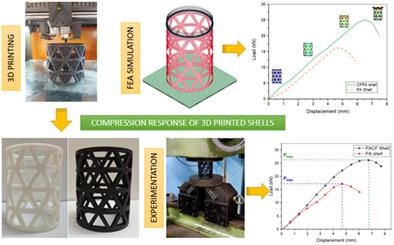当前位置:
X-MOL 学术
›
Polym. Compos.
›
论文详情
Our official English website, www.x-mol.net, welcomes your
feedback! (Note: you will need to create a separate account there.)
Compression behavior of 3D printed isogrid cylindrical shell structures using experimental and finite element modeling
Polymer Composites ( IF 4.8 ) Pub Date : 2022-06-14 , DOI: 10.1002/pc.26792 Anish Jafrin Thilak Johnson 1 , Suresh Paramasivam 2
Polymer Composites ( IF 4.8 ) Pub Date : 2022-06-14 , DOI: 10.1002/pc.26792 Anish Jafrin Thilak Johnson 1 , Suresh Paramasivam 2
Affiliation

|
Lattice structures have been widely used in aircraft and automobile industries due to their excellent mechanical properties namely high specific strength, specific stiffness, and energy absorption capability. On the other hand, additive manufacturing that is considered as an essential for Industry 4.0 offers incredible opportunities for product development and production flexibility. Previous research on 3D printed isogrid structures focused on isogrid panels and their buckling behavior, whereas isogrid lattice cylindrical shells garnered less attention. This work reports the effect of short carbon fiber reinforcement with polyamide three-dimensional printing material on the compression response of isogrid lattice shell structures by experimental and numerical modeling. Isogrid cylindrical shells were three dimensionally printed using fused deposition modeling. Initially, test coupons were printed using polyamide and carbon fiber reinforced polyamide and their mechanical properties were found using uniaxial tensile testing. The obtained tensile properties were given as an input to the numerical modeling performed using LS-DYNA®. The peak load and the maximum displacement of the printed isogrid lattice shells subjected to axial compression loads were experimentally evaluated. The numerical findings were compared with those produced using experimental methods. The error in estimating the peak load of lattice cylinders through numerical modeling was limited to 5.35%. The effect of geometric parameters namely rib width (helical and hoop), shell thickness, helical angle of ribs on the buckling strength was also studied.
中文翻译:

使用实验和有限元建模的 3D 打印等网格圆柱壳结构的压缩行为
晶格结构因其优异的机械性能即高比强度、比刚度和能量吸收能力而被广泛应用于飞机和汽车工业。另一方面,被认为是工业 4.0 必不可少的增材制造为产品开发和生产灵活性提供了难以置信的机会。先前对 3D 打印等网格结构的研究主要集中在等网格面板及其屈曲行为,而等网格晶格圆柱壳受到的关注较少。这项工作通过实验和数值模拟报告了用聚酰胺 3D 打印材料增强短碳纤维对等网格晶格壳结构的压缩响应的影响。使用熔融沉积建模对等网格圆柱壳进行三维打印。最初,使用聚酰胺和碳纤维增强聚酰胺打印测试试样,并使用单轴拉伸测试发现它们的机械性能。将获得的拉伸性能作为使用 LS-DYNA® 进行的数值建模的输入。实验评估了受轴向压缩载荷作用的印刷等格网壳的峰值载荷和最大位移。数值结果与使用实验方法产生的结果进行了比较。通过数值模拟估计晶格圆柱的峰值载荷的误差限制在 5.35%。几何参数的影响,即肋宽度(螺旋和环),壳厚度,
更新日期:2022-06-14
中文翻译:

使用实验和有限元建模的 3D 打印等网格圆柱壳结构的压缩行为
晶格结构因其优异的机械性能即高比强度、比刚度和能量吸收能力而被广泛应用于飞机和汽车工业。另一方面,被认为是工业 4.0 必不可少的增材制造为产品开发和生产灵活性提供了难以置信的机会。先前对 3D 打印等网格结构的研究主要集中在等网格面板及其屈曲行为,而等网格晶格圆柱壳受到的关注较少。这项工作通过实验和数值模拟报告了用聚酰胺 3D 打印材料增强短碳纤维对等网格晶格壳结构的压缩响应的影响。使用熔融沉积建模对等网格圆柱壳进行三维打印。最初,使用聚酰胺和碳纤维增强聚酰胺打印测试试样,并使用单轴拉伸测试发现它们的机械性能。将获得的拉伸性能作为使用 LS-DYNA® 进行的数值建模的输入。实验评估了受轴向压缩载荷作用的印刷等格网壳的峰值载荷和最大位移。数值结果与使用实验方法产生的结果进行了比较。通过数值模拟估计晶格圆柱的峰值载荷的误差限制在 5.35%。几何参数的影响,即肋宽度(螺旋和环),壳厚度,











































 京公网安备 11010802027423号
京公网安备 11010802027423号